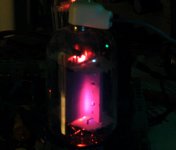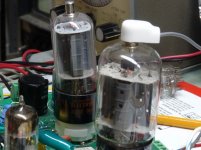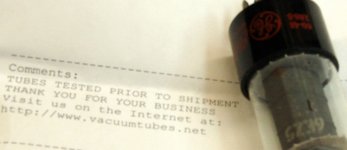kevinkr said:
Wavebourn I was amused to read about your toilet tank search, did you succeed or did you have to buy a new toilet? I've seen guys around here selling tanks for as much as a decent new toilet at Lowes or Home Depot..(They can't sell the entire toilet as that is illegal here for some reason..
)
I found some with very similar distance between bolts, but it was smaller by volume so I had to add a peace of pipe to overflow valve so level of water stays higher to accumulate enough water to flush reliably. It could be a real disaster to replace the entire toilet.
Wavebourn said:
Grid 1 bias voltage is too high?
Couple of weeks ago my tenant called complaining that the neigbor downstairs has wet ceiling in bathroom... Turned to be a crack in a tank. I have to use grinder to remove steel bolts, after that spent 2 days searching for a tank with the same distance between bolts. They all are different!!!
...today I used the same grinder I bought to fix a toilet to fix an error on a PCB.
"No evil without goodness" -- Russian saying.
Edit: I put thick layers of silicone hermetic on both bolts, hope they will be safe now.
hey were copper bolts, and silicone made for kitchen pipes. [/B][/QUOTE]Wavebourn said:
They were copper bolts, and silicone made for kitchen pipes.
No matter what type of rtv silicone it is it still has the problem with acetic, but in lesser quantities. It's a much less dense silicone. But copper isn't nearly a venerable to acetic. Just don't pee on it, then you could have a problem LOL.
I like that saying by the way Wavebourn, I have work with a few Russian engineers I'm surprised I haven't heard it.
kevinkr said:OT Bathroom floods:
I've had a couple of those goofy rubber gaskets go too.. Symptom is a steady drip that never goes away no matter what you do.. I always use brass replacement bolts, but they corrode pretty good in the water around here - I'd replace after 10yrs or so. Newer toilets seem to come with brass bolts..
Wavebourn I was amused to read about your toilet tank search, did you succeed or did you have to buy a new toilet? I've seen guys around here selling tanks for as much as a decent new toilet at Lowes or Home Depot..(They can't sell the entire toilet as that is illegal here for some reason..
)
My least favorite kind of flood was when our sewer main got blocked by roots twice in less than 2 yrs flooding my listening space and workshop both times..The remedy chosen was to reline part of the main with a fiberglas epoxy resin sleeve which was a rather costly non DIY proposition..

Kevin unfortunately all metal will corrode in water, aseptically with chlorine in it. But brass is a much cheaper alternative the others.
Have you ever wondered why you never see stainless used with tap water?????
Stainless is incomparable with chlorides of all types and as the temp goes up so do the severity of the problems. Chlorine and chromium aren't good bedfellows what's so ever. You need nickel ah thats a good one, it can handle high temp too.
Get ya some x750 inconel bolts and they will last longer then the human race in you toilet LOL. Of course they will cost about 50 to 60 bucks a pop.
Ok Metallurgy lesson done,
Sorry for the rant,
Nick
nhuwar said:No matter what type of rtv silicone it is it still has the problem with acetic, but in lesser quantities. It's a much less dense silicone. [/B]
It smells differently. I don't use one that has strong sour smell.
Wavebourn said:
It smells differently. I don't use one that has strong sour smell.
It very well could use a different acid but I would have to delve a little deeper in that, namely check the ph.
But hey I use the stuff allot too rtv silicone is a life saver aseptically around high voltage LOL.
Nick
There are different types of silicone RTVs.
The common “household” type uses acetic acid as the curing agent, hence the strong vinegar odor. The acetic acid can cause corrosion in some metals before the RTV cures.
Some types of silicone RTVs do not use acetic acid but cure by absorbing moisture from the atmosphere. One such type is RTV 162 made by GE. RTV 162 is labeled as an "Electronic Grade" RTV and is useful as an electrical potting material. The absence of acetic acid eliminates corrosion of the metals in electrical components.
The common “household” type uses acetic acid as the curing agent, hence the strong vinegar odor. The acetic acid can cause corrosion in some metals before the RTV cures.
Some types of silicone RTVs do not use acetic acid but cure by absorbing moisture from the atmosphere. One such type is RTV 162 made by GE. RTV 162 is labeled as an "Electronic Grade" RTV and is useful as an electrical potting material. The absence of acetic acid eliminates corrosion of the metals in electrical components.
I've been using E6000 from Wally-Mart: cheap, no acid, flexible, very adhesive. ( doesn't shrink like most glues) Works great on kayaks and vinyl inflatables. Haven't tried it for electronic stuff yet, but I plan to sometime. Fixes shoes well too. (even holds silicon carbide on the soles for rock climbing) Next best thing to Gorilla duct tape in my experience. (I cover my kayak's bottom with that to keep it from getting scraped up in rapids.)
Let's see, we used to use some stuff they called Gorilla Snot for electronics/PC boards, not sure what the real name was.
Don
Let's see, we used to use some stuff they called Gorilla Snot for electronics/PC boards, not sure what the real name was.
Don
tubelab.com said:
There were 6Y6's in the amp already. I was using them to drive some transistors in a "darlington" configuration, because they will work good at 150 volts or less.
And probably want to see only about 1.5 to 2K load at that voltage, maybe about right for the input of the Darlington pair. How are you coupling the 6Y6's into the pair?
Is a Simple SE OTL in the works?
Hope the surgery goes well.
Win W5JAG
SY said:It's a catalytic process, usually done with a platinate.
smoking-amp said:I've been using E6000 from Wally-Mart: cheap, no acid, flexible, very adhesive. ( doesn't shrink like most glues) Works great on kayaks and vinyl inflatables. Haven't tried it for electronic stuff yet, but I plan to sometime. Fixes shoes well too. (even holds silicon carbide on the soles for rock climbing) Next best thing to Gorilla duct tape in my experience. (I cover my kayak's bottom with that to keep it from getting scraped up in rapids.)
Let's see, we used to use some stuff they called Gorilla Snot for electronics/PC boards, not sure what the real name was.
Don
Wow e6000, it has tetrachloroethylene in it, I'll take my chances with the acetic based stuff. Have you heard of trichloroethylene, yet one less chlorine atom. This is probably the key volatile that aids vulcanization.
That stuff is not to good, not that it bothers me I used to take baths in the stuff, well not literally. If in 20 years I get some funky form of cancer I will know why.
Nick
How are you coupling the 6Y6's into the pair?
My "darlington pair" is a hybrid, half tube half transisitor. Take a working cathode biased SE amp. Wire a large High voltage N channel mosfet or NPN bipolar transistor like this. Emitter goes to ground, base goes to the tubes cathode, cathode resistor still in place (E-B). Collector goes to the plate.
I was getting stupid amounts of power, like 25 to 30 watts with a 600 ohm OPT on 100 to 200 volts. Very low distortion numbers too. You will need a good power supply that can crank out some current.
I fixed the amp put in the 6w6's saw about 1.5 watts in triode with a 150 volt supply. I really wasn't into going much farther since a big fat box of tubes were on my doorstep when I got home.
I had been looking for a fat bottled 6BQ6 type tube. I saw one with a plate like you would find in a 6AV5 in it. I have bought some 6bq6's from several vendors, and until today, I haven't seen one. I asked a tube seller to find me the fattest 6BQ6 type tube he could get and send them to me. I got 3 different fat boys. Well, whats next? To slightly misquote Mick Jagger "My favorite color cherry red".
Attachments
These two tubes have the same number on them. The small one is the most common. Note how crooked that it is. The picture above was taken at about 40 watts of dissipation. (56 watts in, 16 delivered to the load). The small ones will melt at that level.
I will have more details next time. The last time I had this surgery my eye was swolen shut for 2 days. So I may not be here for a while.
I will have more details next time. The last time I had this surgery my eye was swolen shut for 2 days. So I may not be here for a while.
Attachments
The AES summer sale is my first venture in buying valves (or better, tubes) from an US based store. Based on the recommendations of EC8010 and Lynn Olson I bought myself a bunch of the 12LC3 damper diodes (and some other models) at <1 US$ the piece, to be used in some 'high voltage' experiments.
tubelab.com said:These two tubes have the same number on them. The small one is the most common. Note how crooked that it is. The picture above was taken at about 40 watts of dissipation. (56 watts in, 16 delivered to the load). The small ones will melt at that level.
I will have more details next time. The last time I had this surgery my eye was swolen shut for 2 days. So I may not be here for a while.
That **** eyed thing would drive me nut's
But I guess if it sounds good you could do something to make it look better, or deal with it.
Nick
That **** eyed thing would drive me nut's
I have read several complaints about some new production tubes being crooked. This is a good example of a vintage RCA leaning tower of thermionic emission. I have seen plenty of others. I only paid $0.98 from AES for this one, so I don't care. The other 9 tubes stand up straight. This one will be used for testing.
tubelab.com said:
I have read several complaints about some new production tubes being crooked. This is a good example of a vintage RCA leaning tower of thermionic emission. I have seen plenty of others. I only paid $0.98 from AES for this one, so I don't care. The other 9 tubes stand up straight. This one will be used for testing.
You I think it's funny I could care less about anything else it's just for some reason that bothers me, goofy.
Probably some Freudian thing saying it because of my Mother LOL.
Nick
No, I just know that this tube is likely going to get melted. Does it matter what it looks like. When I get a bunch of tubes in for testing, I pick the ugliest pair for experiments. This one qualifies. If it survives, it isn't going into an amp, it stays in my collection for experiments.
It's time, I'm off to the hospital for another hole in the head, later.
It's time, I'm off to the hospital for another hole in the head, later.
I was told by the doctor to stay in bed flat on my back all day. I was having enough of that &!@* when I heard the UPS man knock. He could be bringing me tubes, or tubes, or Microshaft software. The odds were in favor of tubes, so I got out of bed. Tubes it was. Did I go back to bed? Do tubes glow?
There are now two boxes of tubes here with a third (the AES box) due on Friday. I already have a Simple SE set up with a variable supply, and fixed bias from the power supply (cathode resistor jumped). I decided to test a few tubes.
First off I got 20 6EZ5's from Radio Electric Supply for $1 each. They resemble a 6W6 and I believe that they are cut from the same mold. I am not feeling up to any serious testing, so I just set the power supply on 300 volts and set the bias for 50 mA, in triode with a 5K OPT, to test the tubes for life.
The 6EZ5 will produce about 1.5 watts under these conditions. All of the good tubes were very consistent, and I did not have to readjust the bias voltage from tube to tube.
The first tube out of the box had a completely white getter, toast. The rest worked, except for one that would draw 100 to 200 mA, and glow the gassy tube glow. OK, 18 good tubes, 2 dead tubes. For $1 each, I'm not going to complain, it would cost more than this to send them back. I included a picture of the dead tube, lying on top of the invoice where it reads "TUBES TESTED PRIOR TO SHIPMENT". Look carefully, there is rust on the plate. Rust doesn't grow in a vacuum, so this tube has been full of Florida moist air for a long time.
There are now two boxes of tubes here with a third (the AES box) due on Friday. I already have a Simple SE set up with a variable supply, and fixed bias from the power supply (cathode resistor jumped). I decided to test a few tubes.
First off I got 20 6EZ5's from Radio Electric Supply for $1 each. They resemble a 6W6 and I believe that they are cut from the same mold. I am not feeling up to any serious testing, so I just set the power supply on 300 volts and set the bias for 50 mA, in triode with a 5K OPT, to test the tubes for life.
The 6EZ5 will produce about 1.5 watts under these conditions. All of the good tubes were very consistent, and I did not have to readjust the bias voltage from tube to tube.
The first tube out of the box had a completely white getter, toast. The rest worked, except for one that would draw 100 to 200 mA, and glow the gassy tube glow. OK, 18 good tubes, 2 dead tubes. For $1 each, I'm not going to complain, it would cost more than this to send them back. I included a picture of the dead tube, lying on top of the invoice where it reads "TUBES TESTED PRIOR TO SHIPMENT". Look carefully, there is rust on the plate. Rust doesn't grow in a vacuum, so this tube has been full of Florida moist air for a long time.
Attachments
- Status
- This old topic is closed. If you want to reopen this topic, contact a moderator using the "Report Post" button.
- Home
- Amplifiers
- Tubes / Valves
- Tube sale at AES



